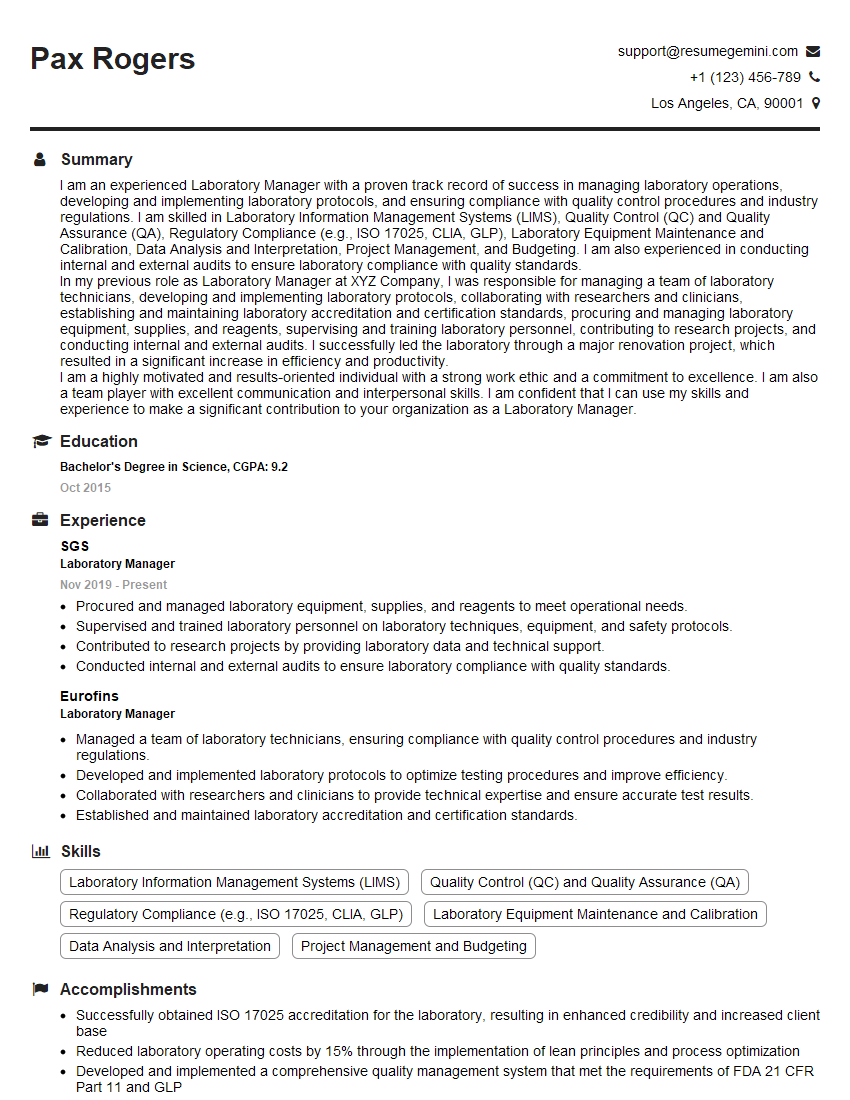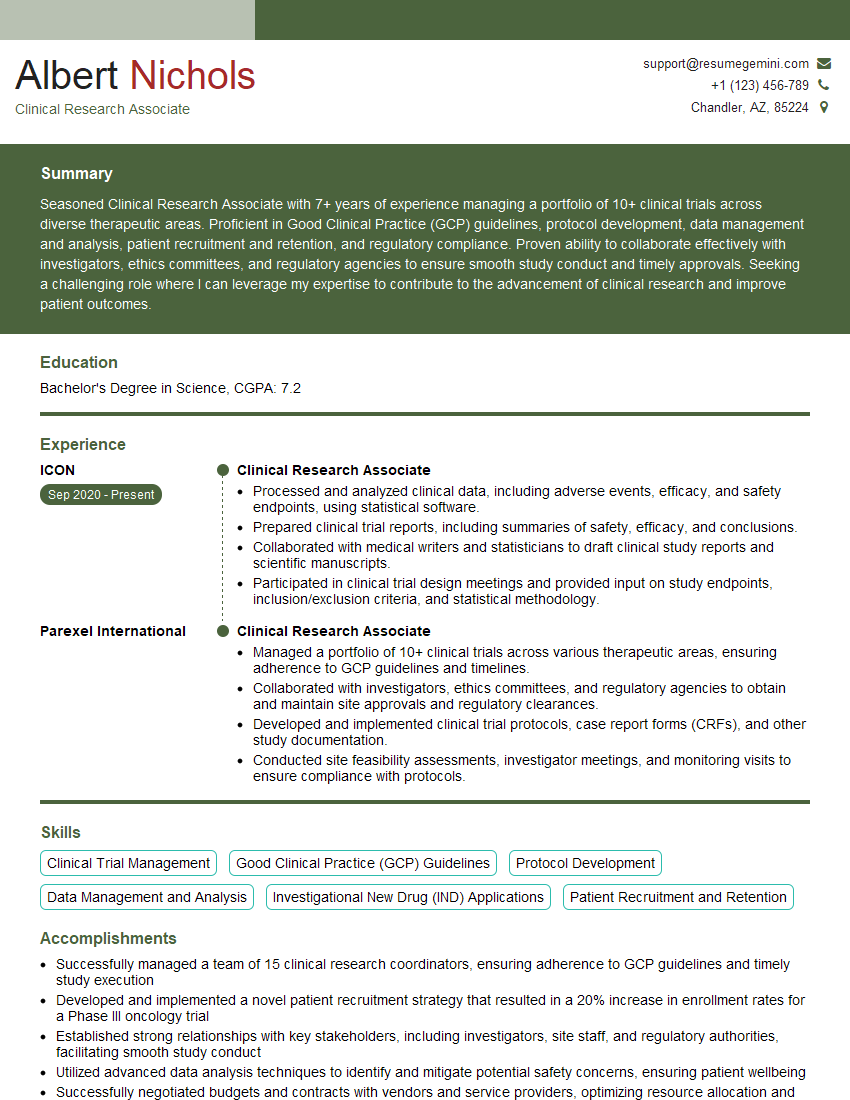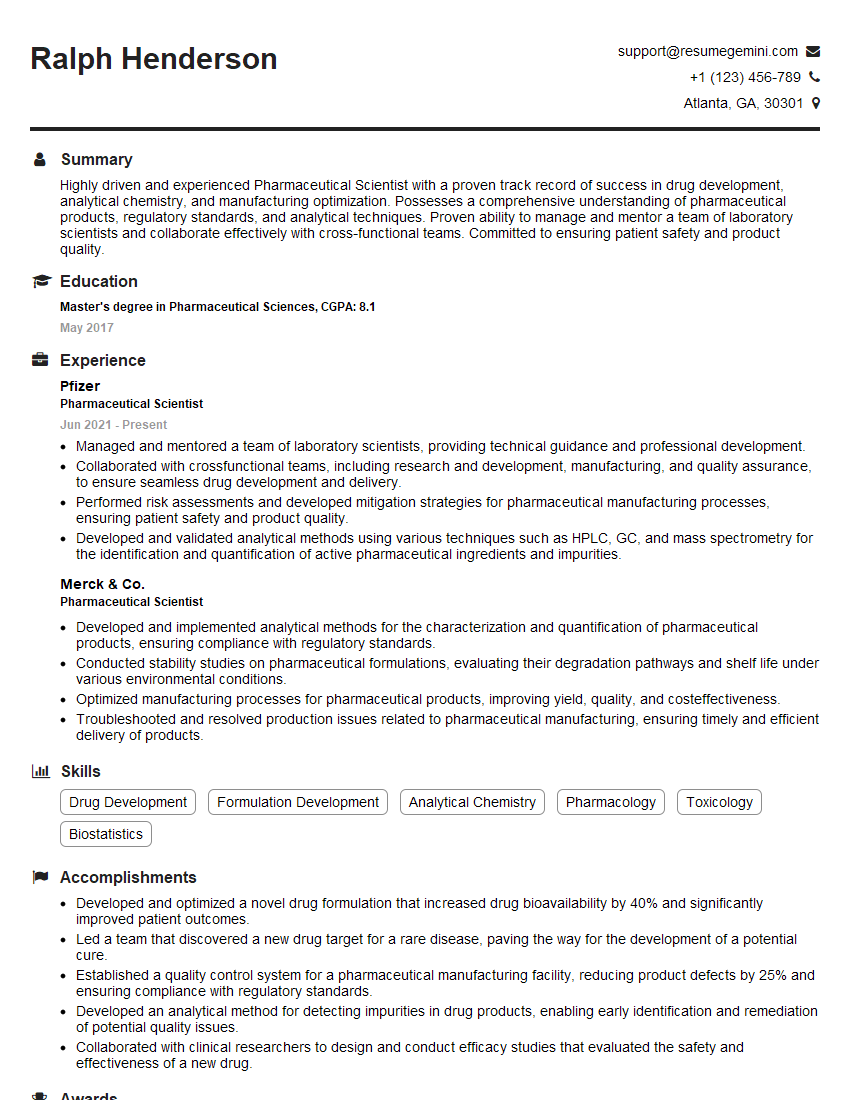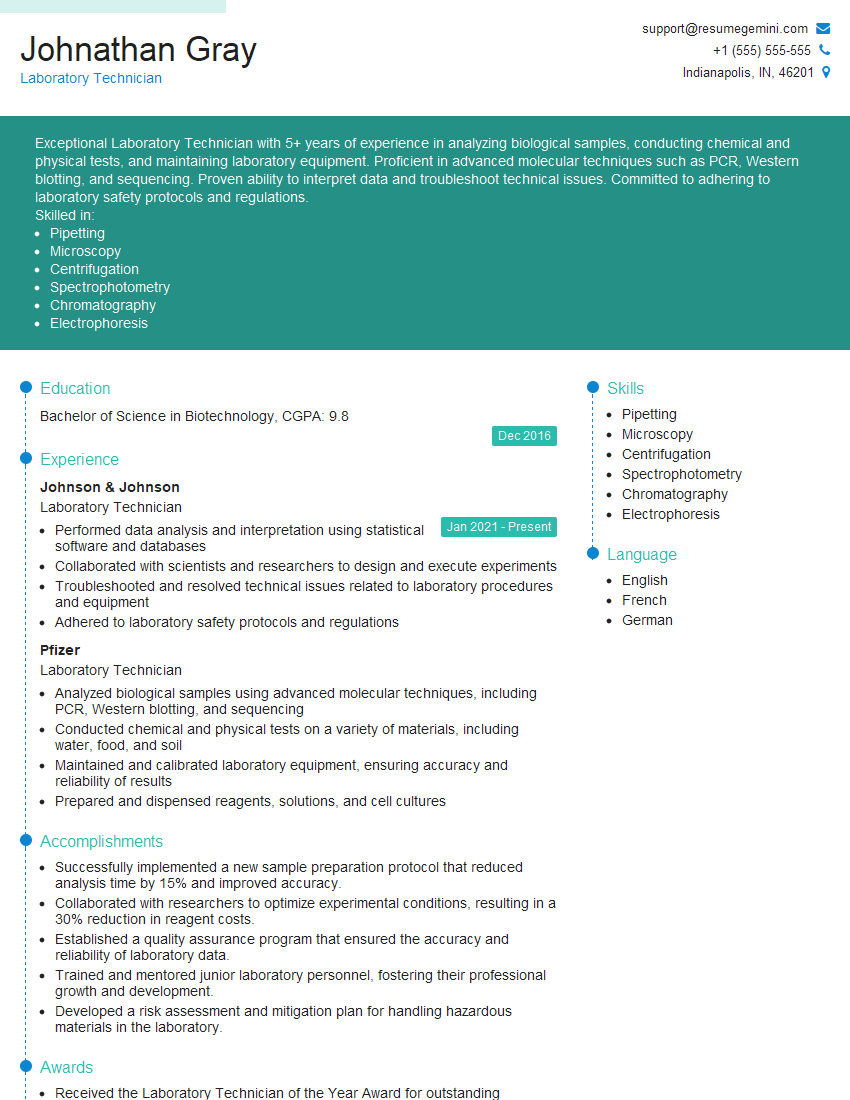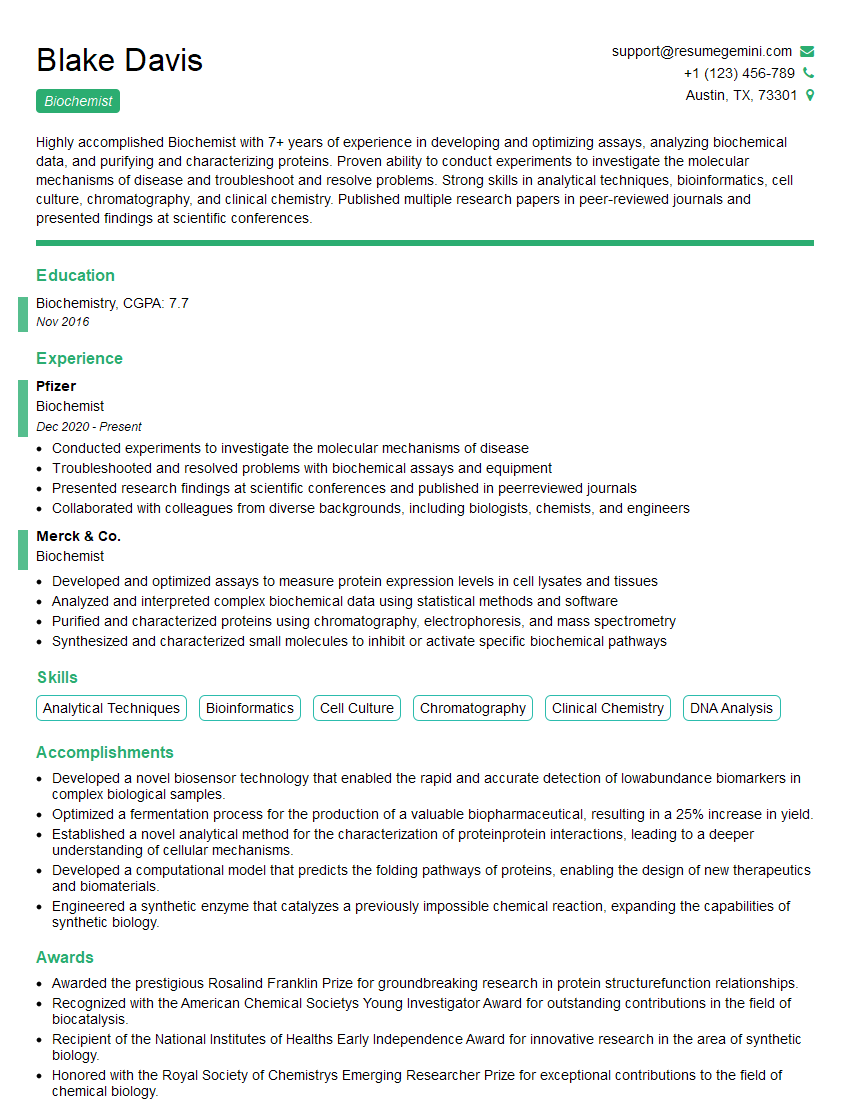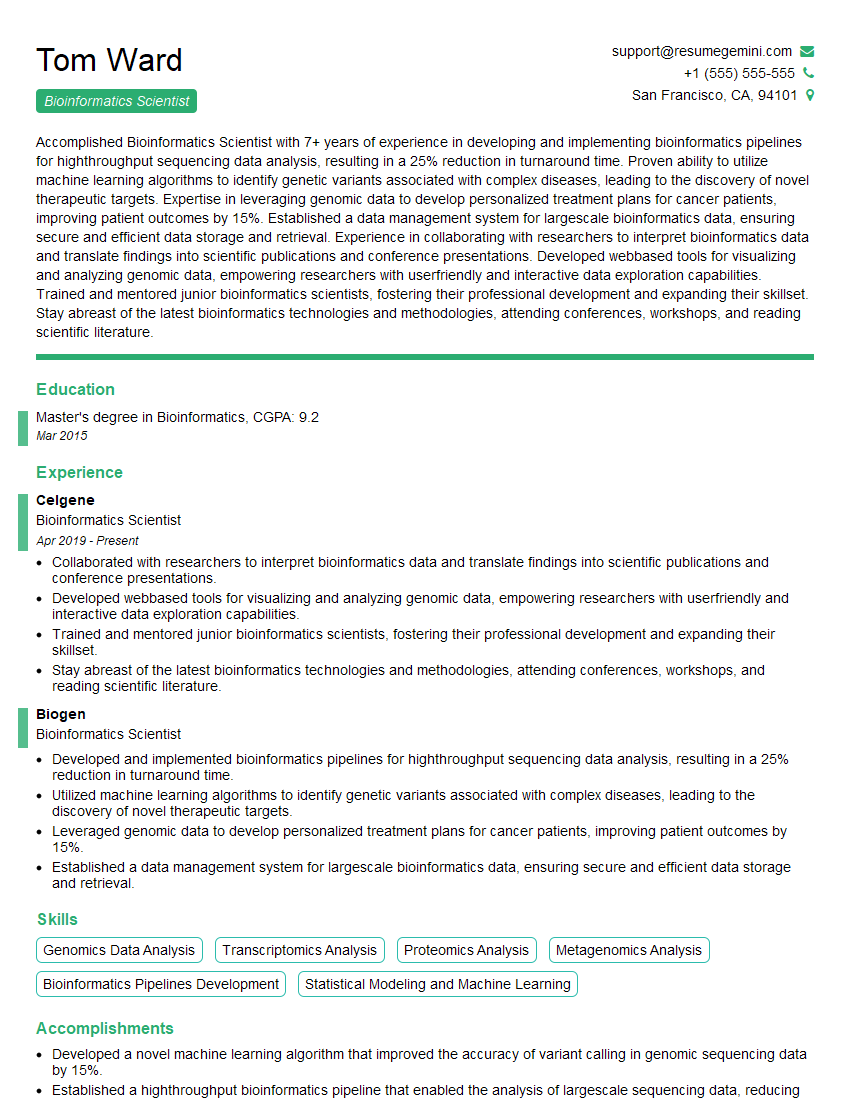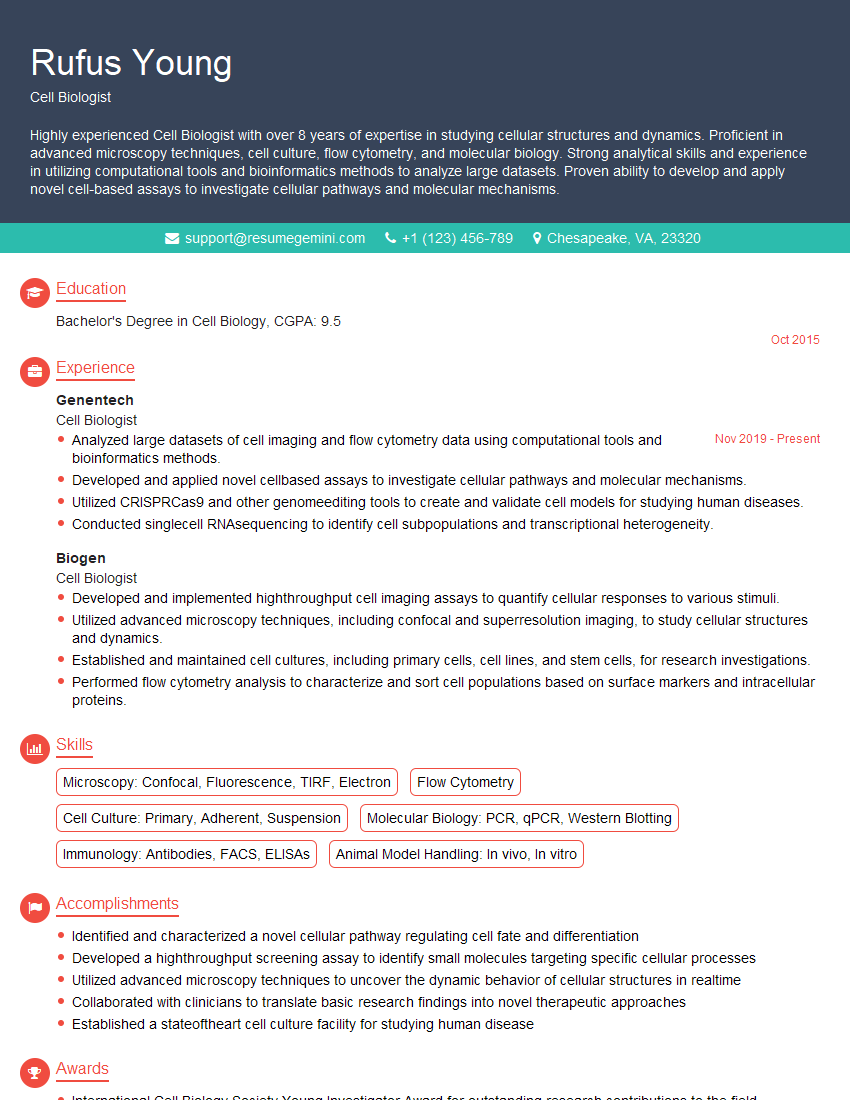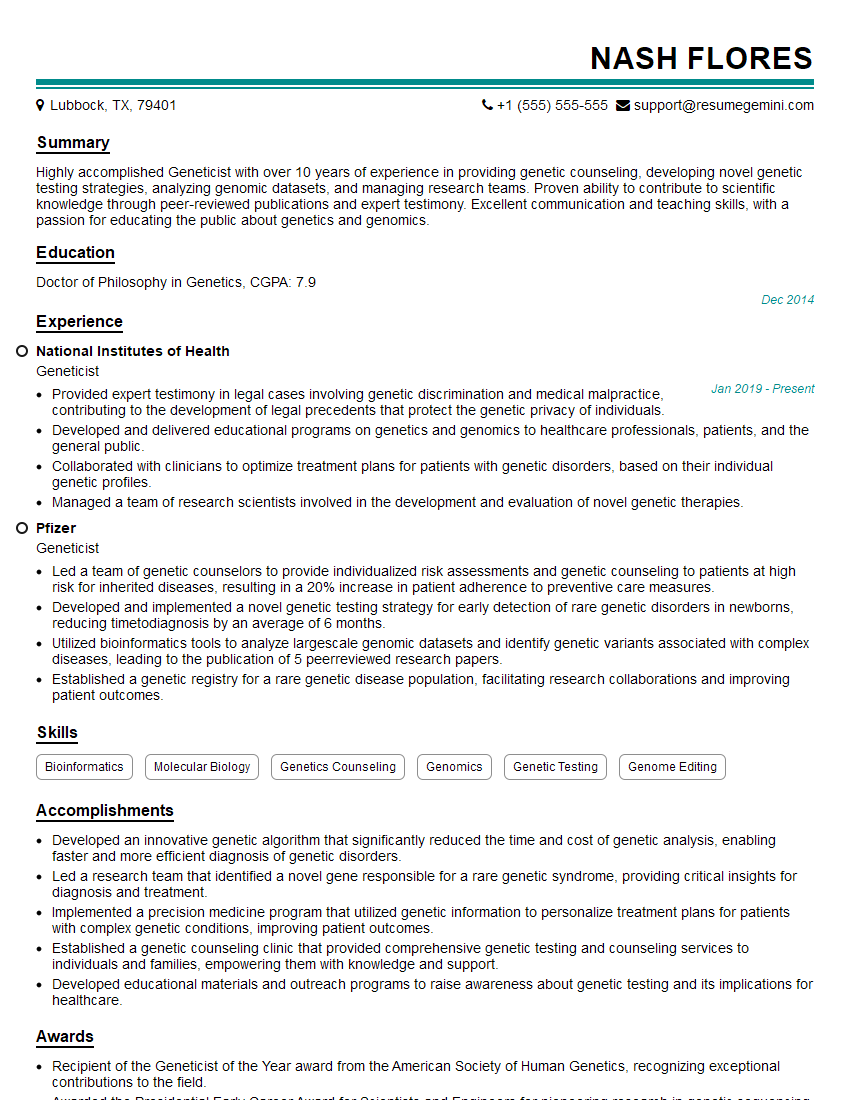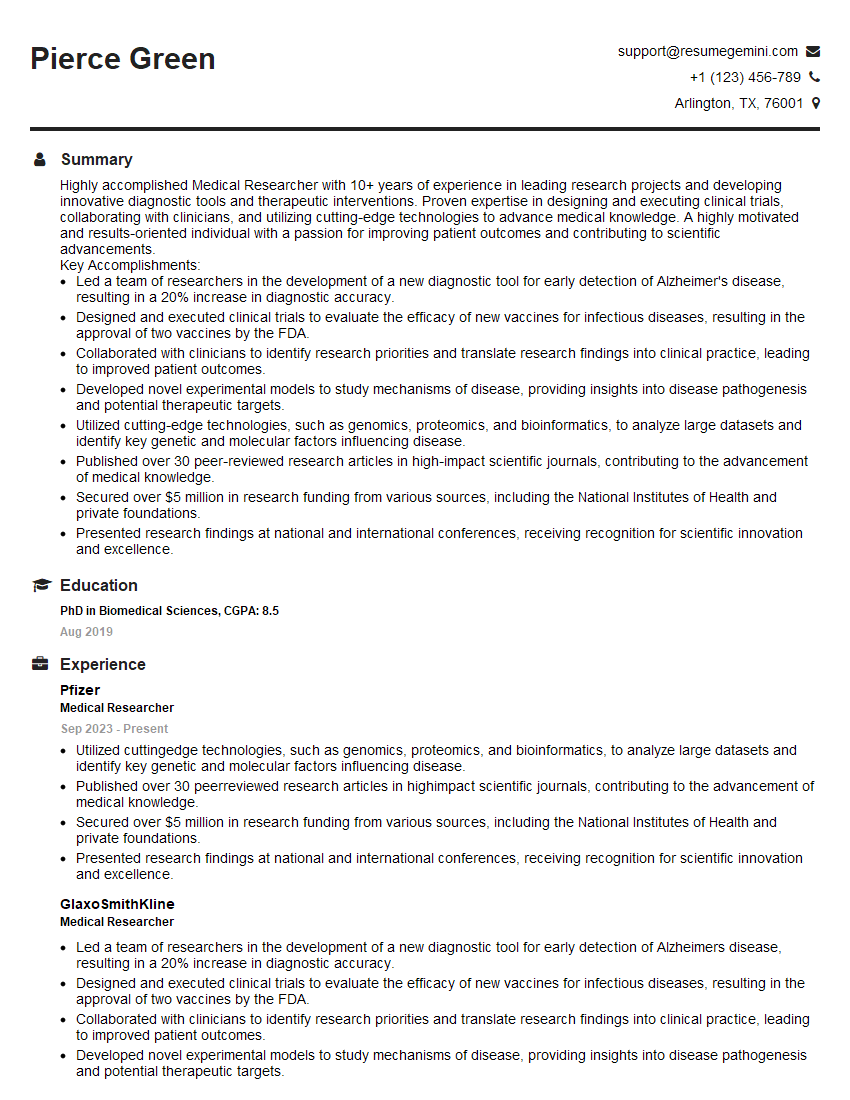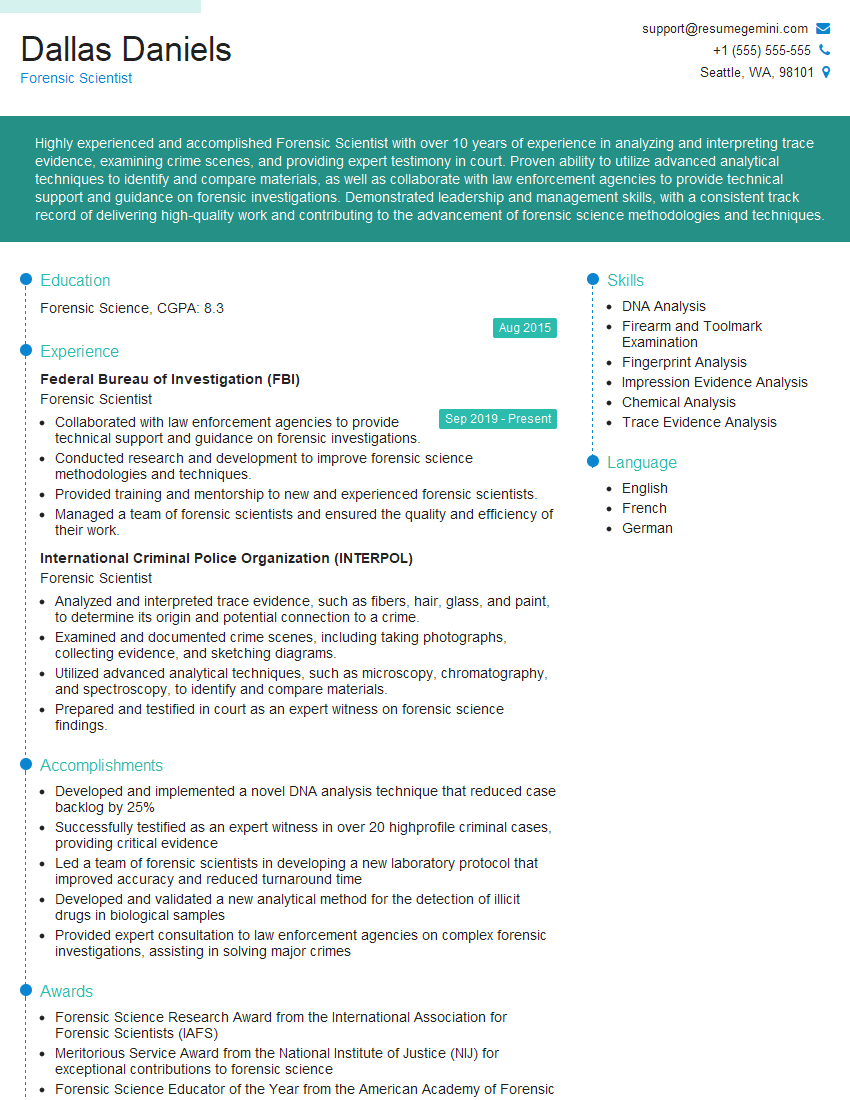Are you ready to stand out in your next interview? Understanding and preparing for Southern Blotting interview questions is a game-changer. In this blog, we’ve compiled key questions and expert advice to help you showcase your skills with confidence and precision. Let’s get started on your journey to acing the interview.
Questions Asked in Southern Blotting Interview
Q 1. Describe the principle behind Southern Blotting.
Southern blotting is a powerful technique used to detect specific DNA sequences within a complex DNA mixture. Imagine you have a huge library filled with books (DNA fragments), and you’re searching for a specific book (DNA sequence). Southern blotting helps you find that specific book by using a labeled probe that binds only to that particular book. The principle lies in separating DNA fragments by size through electrophoresis, transferring them to a membrane, and then probing the membrane with a labeled DNA sequence complementary to the target DNA. This allows for the visualization of the target DNA fragment.
Q 2. What are the key steps involved in performing a Southern Blot?
Performing a Southern blot involves several crucial steps:
- DNA Extraction and Digestion: First, genomic DNA is extracted from the sample. Then, restriction enzymes—molecular scissors—cut the DNA at specific recognition sites, generating fragments of varying sizes.
- Electrophoresis: The digested DNA fragments are separated by size using agarose gel electrophoresis. Smaller fragments migrate faster than larger ones, creating a pattern of bands.
- Denaturation: The DNA is denatured, meaning the double-stranded DNA is separated into single strands, making it accessible to the probe.
- Transfer to Membrane: The separated DNA fragments are transferred from the gel to a membrane (usually nylon or nitrocellulose) via capillary action or electroblotting. This creates a replica of the DNA bands on the membrane.
- Prehybridization: The membrane is prehybridized to block non-specific binding sites, reducing background noise.
- Hybridization: A labeled DNA probe, complementary to the target sequence, is added to the membrane. The probe hybridizes (binds) to its complementary sequence on the membrane.
- Washing: Unbound probe is washed away.
- Detection: The location of the hybridized probe is detected using autoradiography (if radioactively labeled) or chemiluminescence (if non-radioactively labeled).
Q 3. What is the purpose of using restriction enzymes in Southern Blotting?
Restriction enzymes are crucial because they cut the genomic DNA into manageable fragments. Without digestion, the DNA would be too large to separate effectively by electrophoresis. Each restriction enzyme recognizes a specific DNA sequence, allowing researchers to generate reproducible fragments. The choice of enzyme(s) depends on the target sequence and the desired fragment size. For example, if you know the approximate location of your target sequence and its flanking regions, you can choose an enzyme that cuts outside of those regions, producing a fragment containing your sequence.
Q 4. Explain the role of electrophoresis in Southern Blotting.
Electrophoresis separates DNA fragments based on their size. The negatively charged DNA fragments migrate through an agarose gel matrix towards the positive electrode. Smaller fragments move faster and farther than larger ones, creating a pattern of bands. This separation is essential to resolve the target DNA fragment from other DNA fragments and allow for its specific detection.
Q 5. What is the purpose of denaturation in Southern Blotting?
Denaturation is the process of separating double-stranded DNA into single strands. This is essential because the DNA probe, which is also single-stranded, can only hybridize (bind) to its complementary sequence if the DNA is single-stranded. Without denaturation, the probe wouldn’t be able to access and bind to the target DNA sequence.
Q 6. What is a probe in Southern Blotting, and how is it chosen?
A probe in Southern blotting is a single-stranded DNA fragment that is complementary to the target DNA sequence. It’s essentially the ‘key’ that unlocks the specific DNA sequence we are looking for. The probe is chosen based on knowledge of the target sequence. This knowledge might come from prior research, existing databases (like GenBank), or even through designing a probe based on the conserved regions of a gene family.
For example, if you’re studying a specific gene, you would design a probe based on a unique region of that gene’s sequence. You want to avoid probes that are too short (leading to non-specific binding) or too long (leading to low sensitivity).
Q 7. Describe the process of probe labeling.
Probe labeling involves attaching a detectable marker to the DNA probe. This marker allows for the visualization of the hybridized probe on the membrane. Common labeling methods include:
- Radioactive labeling: Using radioactive isotopes like 32P to label nucleotides in the probe. Detection is done through autoradiography.
- Non-radioactive labeling: Using chemicals that produce chemiluminescence or fluorescence. Detection is done using appropriate detection systems that can visualize the signal emitted by these markers. These methods are safer and easier to handle than radioactive labeling.
The choice of labeling method depends on the available resources, sensitivity requirements, and safety considerations. Non-radioactive labeling is increasingly preferred due to safety concerns and the development of sensitive detection methods.
Q 8. Explain the role of hybridization in Southern Blotting.
Hybridization is the cornerstone of Southern blotting. It’s the process where a single-stranded DNA probe, designed to be complementary to a specific DNA sequence of interest, binds to its target sequence on the membrane. Imagine it like finding a specific book (your target DNA sequence) in a massive library (your DNA sample) using a bookmark with a unique inscription (your DNA probe). The probe, labeled with a detectable marker (like radioactivity or fluorescence), only sticks to the complementary sequence, allowing us to identify and locate that specific gene or DNA fragment within the complex mixture.
This specific binding is based on the principle of base pairing – adenine (A) pairing with thymine (T), and guanine (G) pairing with cytosine (C). The higher the degree of complementarity, the stronger and more stable the hybridization.
Q 9. How is stringency controlled in Southern Blotting?
Stringency in Southern blotting refers to the conditions that determine the specificity of the hybridization reaction. We need to strike a balance: high stringency ensures that only perfectly or near-perfectly matched probes bind, minimizing false positives; low stringency allows for some mismatches, potentially increasing sensitivity but risking false positives. Stringency is controlled by manipulating two primary factors:
- Temperature: Higher temperatures favor highly specific binding because only perfectly matched probes can withstand the thermal energy and remain bound. Lower temperatures allow for less stringent hybridization.
- Salt concentration: Lower salt concentrations increase stringency, again favoring perfectly matched sequences. Higher salt concentrations reduce stringency, allowing for more mismatches.
For example, in a Southern blot aiming to detect a highly conserved gene, we might use higher stringency conditions to avoid cross-hybridization with similar sequences. Conversely, when looking for a highly variable gene with possible mutations, lower stringency would allow the detection of a broader range of variations.
Q 10. What are the different types of probes used in Southern Blotting?
Southern blotting employs various types of probes, each offering different advantages:
- Oligonucleotide probes: These are short, single-stranded DNA sequences (typically 20-50 bases). They’re highly specific and easy to synthesize, ideal for detecting point mutations or small variations.
- cDNA probes: These are complementary DNAs synthesized from mRNA. They’re used to identify specific genes expressed in a given tissue or cell type.
- Genomic DNA probes: These are DNA fragments cloned from a genomic library. They’re useful for detecting larger genomic regions, including introns and exons.
- Random-primed labeled DNA probes: These are synthesized by random priming of a DNA template. They offer more comprehensive coverage of a genomic region.
The choice of probe type depends on the research question. If you are interested in a particular gene’s expression, a cDNA probe is suitable; if you are interested in detecting a specific polymorphism in a particular region, an oligonucleotide probe would be chosen.
Q 11. How is the signal detected in Southern Blotting?
Signal detection in Southern blotting relies on the label attached to the probe. Historically, radioactive isotopes like 32P were commonly used. The membrane is exposed to X-ray film, and the radioactive decay produces a signal visible as dark bands corresponding to the locations of the target DNA. More modern methods use non-radioactive labels, such as:
- Chemiluminescence: The probe is labeled with a molecule that emits light upon reaction with a substrate. This light signal can be captured on film or with a chemiluminescence imager.
- Fluorescence: The probe is labeled with a fluorophore that emits light at a specific wavelength when excited by a laser. A fluorescence scanner detects this light, quantifying the signal.
These non-radioactive methods offer enhanced safety and often provide better sensitivity and quantification compared to radioactive detection.
Q 12. What are some common troubleshooting steps for a failed Southern Blot?
Troubleshooting a failed Southern blot often involves systematically checking each step. Here’s a common framework:
- DNA digestion: Ensure complete digestion of the genomic DNA. Incomplete digestion leads to smeared bands instead of sharp bands. Re-run the digestion using fresh enzymes and optimized conditions.
- Transfer efficiency: Verify that DNA is effectively transferred from the gel to the membrane. Check for any gaps or incomplete transfer, and repeat the transfer process if needed.
- Pre-hybridization and hybridization conditions: Optimize the stringency of the hybridization to avoid non-specific binding. Ensure proper blocking of the membrane.
- Probe quality and labeling: Check probe integrity; degradation can drastically reduce signal intensity. Check labeling efficiency to ensure sufficient signal is produced.
- Detection method: Ensure the detection method is working properly. This includes checking reagents and equipment calibration.
A methodical approach, combined with careful attention to detail at each step, is critical for successfully troubleshooting Southern blots.
Q 13. How can you optimize the efficiency of a Southern Blot?
Optimizing Southern blotting efficiency involves several strategies:
- High-quality DNA: Use high-molecular-weight, intact genomic DNA to ensure proper digestion and transfer. Degradation leads to poor results.
- Appropriate restriction enzyme choice: Select restriction enzymes that generate fragments of appropriate size for your target DNA. Overly many or too few fragments can complicate interpretation.
- Optimized transfer conditions: Ensure complete and even transfer of DNA from gel to membrane, avoiding artifacts or incomplete transfer.
- High-specific activity probe: Use a probe with high specific activity for strong signal detection. Modern non-radioactive methods enhance this substantially.
- Optimized hybridization and washing conditions: Fine-tune stringency to minimize non-specific binding while maintaining sufficient sensitivity.
By carefully optimizing each of these parameters, you can increase the sensitivity and reproducibility of your Southern blot experiments.
Q 14. What are the limitations of Southern Blotting?
Despite its historical significance, Southern blotting has some limitations:
- Time-consuming: The procedure is relatively lengthy, requiring multiple steps and significant time commitment.
- Requires large amounts of DNA: Sufficient DNA is needed for effective visualization. This might be a limitation for samples with limited availability.
- Limited sensitivity: While sensitivity has improved with newer detection methods, it remains less sensitive compared to PCR-based techniques for some applications.
- Resolution limitations: Resolving very small DNA fragments can be challenging, leading to potential overlapping bands.
These limitations have led to the development of more advanced techniques, such as PCR and next-generation sequencing, which offer higher throughput, sensitivity, and automation. However, Southern blotting remains valuable in specific research areas where its unique capabilities are essential.
Q 15. What are the applications of Southern Blotting in genetic research?
Southern blotting is a powerful technique used to detect specific DNA sequences within a complex mixture of DNA. Think of it like searching for a specific needle in a massive haystack of needles. Its applications in genetic research are diverse and crucial.
- Gene mapping and cloning: Identifying the location of a gene on a chromosome or isolating a specific gene from a genome.
- Genetic fingerprinting: Used in forensic science and paternity testing to analyze DNA variations between individuals.
- Disease diagnosis: Detecting the presence of specific genetic mutations associated with diseases like sickle cell anemia or cystic fibrosis.
- Study of gene expression: Although less common than Northern blotting for this purpose, it can be used to study the presence or absence of a specific gene in a sample.
- Analysis of DNA methylation: Identifying methylated regions in DNA, which are crucial in gene regulation.
For example, researchers might use Southern blotting to confirm the successful insertion of a gene into a genetically modified organism or to identify a specific genetic variation linked to a disease in a patient sample.
Career Expert Tips:
- Ace those interviews! Prepare effectively by reviewing the Top 50 Most Common Interview Questions on ResumeGemini.
- Navigate your job search with confidence! Explore a wide range of Career Tips on ResumeGemini. Learn about common challenges and recommendations to overcome them.
- Craft the perfect resume! Master the Art of Resume Writing with ResumeGemini’s guide. Showcase your unique qualifications and achievements effectively.
- Don’t miss out on holiday savings! Build your dream resume with ResumeGemini’s ATS optimized templates.
Q 16. Compare and contrast Southern Blotting with Northern and Western Blotting.
Southern, Northern, and Western blotting are all related techniques used to detect specific molecules. However, they differ significantly in the target molecule and the probe used.
| Feature | Southern Blotting | Northern Blotting | Western Blotting |
|---|---|---|---|
| Target Molecule | DNA | RNA | Protein |
| Probe | DNA probe | RNA probe (cDNA or RNA) | Antibody |
| Membrane | Nitrocellulose or nylon | Nitrocellulose or nylon | Nitrocellulose or PVDF |
| Application | Gene mapping, genetic fingerprinting, diagnostics | Gene expression analysis | Protein expression analysis |
In essence, Southern blotting analyzes DNA, Northern blotting analyzes RNA, and Western blotting analyzes protein. They all share a similar principle of separating molecules, transferring them to a membrane, and then using a labeled probe to detect the target molecule. However, the probes and the types of molecules being analyzed are different.
Q 17. How is Southern Blotting used in forensic science?
In forensic science, Southern blotting plays a critical role in DNA fingerprinting or profiling. It is used to identify individuals based on variations in their DNA. This is particularly useful in crime investigations, paternity testing, and identification of human remains.
The process involves extracting DNA from a sample (e.g., blood, semen, hair), digesting it with restriction enzymes to create fragments of varying sizes, separating the fragments by gel electrophoresis, transferring the fragments to a membrane, and then probing the membrane with a labeled DNA probe that recognizes specific DNA sequences, like Variable Number Tandem Repeats (VNTRs), which are highly variable among individuals. The resulting banding pattern is unique to an individual, serving as their DNA fingerprint.
Q 18. How is Southern Blotting used in diagnostics?
Southern blotting has diagnostic applications, though it’s less frequently used now compared to PCR-based methods due to its time-consuming nature. However, it remains relevant in certain scenarios.
- Detecting genetic mutations: Southern blotting can identify specific mutations associated with inherited diseases by detecting changes in the size or number of DNA fragments after restriction enzyme digestion. For example, it can be used to detect mutations in the gene responsible for cystic fibrosis.
- Detecting gene rearrangements: It can detect chromosomal rearrangements, such as translocations, which are often implicated in cancer.
- Analyzing viral DNA integration: Southern blotting can be used to detect the integration of viral DNA into the host cell’s genome, as is seen in certain viral infections.
While powerful, the time and resources required often make PCR-based methods more suitable for routine diagnostics. Southern blotting finds its niche in research and specific diagnostic scenarios where its unique capabilities are essential.
Q 19. Explain the concept of single nucleotide polymorphism (SNP) detection using Southern Blotting.
Single nucleotide polymorphisms (SNPs) are single base-pair variations in DNA sequences. Southern blotting can detect SNPs, although it’s not the most efficient method compared to modern techniques like SNP arrays or next-generation sequencing. However, it can be useful in specific cases.
The detection relies on the use of restriction enzymes. If an SNP alters a restriction site (the specific DNA sequence recognized and cut by a restriction enzyme), the resulting DNA fragments will be different in size compared to the fragments from a non-SNP containing DNA sequence. These size differences can be visualized by Southern blotting. The probe will then hybridize to the specific region containing the SNP, and the difference in band size on the blot will indicate the presence of the SNP.
For example, if a SNP destroys a restriction enzyme site, a single large fragment will be observed instead of the two smaller fragments that would be observed if the SNP were not present.
Q 20. What are the safety precautions needed when performing a Southern Blot?
Southern blotting involves working with hazardous chemicals and radioactive materials, demanding careful adherence to safety precautions.
- Use of appropriate personal protective equipment (PPE): Gloves, lab coats, and eye protection are essential.
- Work in a designated laboratory: A well-ventilated laboratory with designated areas for handling radioactive materials is critical.
- Proper disposal of radioactive waste: Radioactive materials should be disposed of according to established protocols.
- Safe handling of chemicals: Follow the safety data sheets for all chemicals used.
- Radiation monitoring: Use radiation monitoring devices to ensure safe working conditions.
Following these protocols ensures a safe working environment and prevents accidental exposure to harmful materials.
Q 21. How do you ensure the accuracy and reproducibility of your Southern Blot results?
Ensuring accuracy and reproducibility in Southern blotting requires attention to detail at every step.
- High-quality DNA: Use high-quality, purified DNA free of contaminants.
- Optimal restriction enzyme digestion: Ensure complete digestion by using the appropriate amount of enzyme and incubation time.
- Proper gel electrophoresis: Use the appropriate gel concentration and running conditions to achieve optimal separation of DNA fragments.
- Efficient transfer: Ensure complete transfer of DNA from the gel to the membrane.
- Stringent hybridization conditions: Use appropriate stringency to ensure specific binding of the probe to the target DNA sequence.
- Appropriate controls: Include positive and negative controls to validate the results.
- Replicates: Perform multiple replicates to ensure reproducibility.
By carefully controlling each step, and using appropriate positive and negative controls, any experimental bias is reduced or removed. This leads to more accurate results and establishes confidence in the findings. Maintaining detailed records of each step is crucial for reproducibility.
Q 22. How can you interpret the results of a Southern Blot?
Interpreting Southern blot results involves analyzing the bands visualized on the autoradiogram or chemiluminescent image. Each band represents a DNA fragment of a specific size that hybridized with your probe. The intensity of the band reflects the amount of that specific DNA fragment present in your sample.
For example, if you’re investigating a gene deletion, you might expect a weaker or absent band in the patient sample compared to a control sample. Conversely, a gene duplication might show a stronger band. The size of the band, determined by comparison to a DNA ladder, tells you the precise length of the DNA fragment. Careful consideration of band size and intensity, in conjunction with the experimental design, will lead you to meaningful conclusions.
Let’s say you’re studying a particular gene’s methylation pattern. You might digest your genomic DNA with a restriction enzyme sensitive to methylation. A band present in a control sample but absent in a treated (methylated) sample would indicate the methylation site is within the restriction enzyme recognition sequence. Analyzing this pattern across multiple samples helps determine the methylation state and its implications.
Q 23. Describe the importance of proper sample preparation in Southern Blotting.
Proper sample preparation is paramount for successful Southern blotting. High-quality DNA, free from degradation and contamination, is crucial for obtaining accurate and reliable results. Degradation leads to smeared bands instead of crisp, well-defined ones, hindering accurate size determination. Contamination can produce false positives, leading to misinterpretations.
The process typically involves high-molecular-weight DNA extraction, carefully quantified to ensure consistent loading across samples. This is followed by a complete restriction digest to fragment the DNA, using enzymes chosen to cut at specific sites relevant to the target sequence. Incomplete digestion can lead to non-specific hybridization and confusing results. Finally, electrophoresis separates the DNA fragments by size to prepare for transfer to the membrane.
Imagine baking a cake – if your ingredients are of poor quality or improperly measured, your cake will be a disaster. Similarly, poor DNA preparation will result in a failed or misleading Southern blot experiment.
Q 24. What is the role of blocking agents in Southern Blotting?
Blocking agents in Southern blotting prevent non-specific binding of the labeled probe to the membrane. After the DNA is transferred to the membrane, it is incubated in a solution containing a blocking agent, which occupies any remaining binding sites on the membrane that aren’t occupied by the DNA. This prevents the probe from binding to the membrane itself rather than to its target sequence.
Common blocking agents include non-fat dry milk, bovine serum albumin (BSA), and commercially available blocking solutions. These agents typically contain proteins that competitively bind to the membrane, thus reducing background noise and making the signal from the probe more clear. Without blocking, the background signal would be overwhelmingly high, making it near impossible to see specific bands.
Think of it like painting a wall. You need a primer to prevent the paint from soaking into the wall unevenly and creating an ugly blotchy look. Blocking agents do the same for the probe, ensuring clean and clear results.
Q 25. How is the size of DNA fragments determined in Southern Blotting?
DNA fragment size is determined by comparing the migration distance of the sample fragments to that of DNA markers or ladders of known sizes during electrophoresis. These markers are run alongside the sample fragments on the gel. After electrophoresis and transfer, the positions of the bands on the Southern blot are compared to the positions of the DNA markers, allowing for size estimation. This is often done using image analysis software to obtain precise measurements.
The size of each fragment is typically expressed in kilobase pairs (kb). Specialized software can automatically measure the size by comparing the migration of the bands to the pre-loaded DNA ladder. The relative migration distances, considering the gel’s matrix and running conditions, give an accurate estimation of the DNA fragment size.
For instance, if a band migrates to the same position as the 5kb marker on the ladder, it is approximately 5kb in length. This relationship, determined from the migration of the DNA ladder, enables accurate determination of the fragment size in the experiment.
Q 26. How does DNA concentration affect Southern Blotting results?
DNA concentration directly influences the intensity of the bands on a Southern blot. Higher DNA concentrations lead to more intense bands because there’s more target DNA available to hybridize with the probe. However, excessively high concentrations can result in saturation of the probe, leading to inaccurate quantification and possibly non-specific binding. Conversely, too low a DNA concentration results in weak or faint bands, making it difficult to detect the target sequences.
Optimal DNA concentration is determined empirically for each experiment. Pilot experiments testing a range of concentrations are typically used to find the sweet spot where the bands are clearly visible and quantifiable without background noise or saturation. A proper loading control, such as a housekeeping gene, helps confirm even loading across all lanes and accounts for any concentration differences.
Imagine it like photography – too much light leads to overexposure, while too little light results in a dark, unclear image. Similarly, an appropriate DNA concentration ensures the optimal ‘exposure’ to achieve optimal results in the Southern Blot.
Q 27. What alternative techniques exist for analyzing DNA fragments?
While Southern blotting is a classic technique, several alternative methods exist for analyzing DNA fragments. These include Polymerase Chain Reaction (PCR)-based techniques, such as quantitative PCR (qPCR) and digital PCR (dPCR), which offer higher sensitivity and specificity. Next-generation sequencing (NGS) technologies provide even more comprehensive information, allowing for the analysis of entire genomes or specific regions of interest.
Other techniques include Pulsed-Field Gel Electrophoresis (PFGE), used for analyzing very large DNA fragments, and microarray technology, useful for analyzing the expression levels of multiple genes simultaneously. The choice of method depends on the specific research question and the nature of the DNA being analyzed. Each technique has its own advantages and limitations, with NGS now becoming the method of choice for many applications due to its high throughput and accuracy.
For instance, qPCR provides quantitative data on the amount of target DNA present, which is not always easily obtained from a Southern blot. NGS allows for detailed analysis of sequence variation, which is impossible with Southern blotting alone. Choosing the right technique is crucial for getting the most meaningful results.
Q 28. How can you quantify the results obtained from Southern blotting?
Quantifying Southern blot results is typically achieved using densitometry, a technique that measures the intensity of bands on an image. Specialized software analyzes the autoradiogram or chemiluminescent image to determine the optical density of each band. This density is directly proportional to the amount of DNA present in that band. To achieve accurate quantification, appropriate controls are crucial to ensure consistent loading, transfer efficiency, and probe hybridization across different samples.
Normalization is often performed by comparing the band intensities to a reference band, such as a housekeeping gene, to account for variations in loading and transfer efficiency. The results are then expressed relative to the reference band or as a fold change compared to a control sample. Careful calibration of the densitometer and proper image processing are critical for accurate and reproducible quantification.
This method, while effective, has limitations. The dynamic range is often limited, and accurate quantification requires optimal exposure and careful consideration of background noise. Advanced techniques like fluorescently labeled probes may enhance quantification, but careful normalization is still essential for accurate comparison of samples.
Key Topics to Learn for Southern Blotting Interview
- DNA Extraction and Purification: Understand the critical steps involved in obtaining high-quality DNA for optimal blotting results. Consider the impact of different extraction methods on subsequent steps.
- Restriction Enzyme Digestion: Master the principles of restriction enzyme digestion and their role in fragmenting DNA for Southern blotting. Be prepared to discuss optimal enzyme selection and troubleshooting digestion issues.
- Gel Electrophoresis: Explain the theory behind agarose gel electrophoresis and its application in separating DNA fragments by size. Understand factors affecting resolution and migration.
- DNA Transfer (Blotting): Detail the process of transferring DNA fragments from the gel to a membrane. Discuss different blotting methods (capillary, vacuum) and their advantages/disadvantages. Be able to troubleshoot common transfer problems.
- Probe Preparation and Hybridization: Explain the principles of probe design and labeling (radioactive or non-radioactive). Understand the hybridization process and factors influencing its efficiency (stringency, temperature).
- Detection and Visualization: Describe the methods used to visualize hybridized probes (e.g., autoradiography, chemiluminescence). Discuss the interpretation of results and potential sources of error.
- Applications of Southern Blotting: Be ready to discuss the practical applications of Southern blotting, including gene mapping, genome analysis, disease diagnosis, and forensic science. Provide specific examples.
- Troubleshooting Common Issues: Anticipate potential problems during each step of the Southern blotting procedure and how to address them. This demonstrates practical experience and problem-solving skills.
- Comparison with other techniques: Be prepared to compare and contrast Southern blotting with other molecular biology techniques like Northern and Western blotting, highlighting their respective strengths and weaknesses.
Next Steps
Mastering Southern Blotting demonstrates a strong foundation in molecular biology techniques, significantly enhancing your career prospects in research, diagnostics, or related fields. To increase your chances of landing your dream role, creating an ATS-friendly resume is crucial. ResumeGemini is a trusted resource that can help you build a professional and impactful resume tailored to highlight your Southern Blotting expertise. Examples of resumes specifically tailored for Southern Blotting positions are available through ResumeGemini to help you create a compelling application.
Explore more articles
Users Rating of Our Blogs
Share Your Experience
We value your feedback! Please rate our content and share your thoughts (optional).
What Readers Say About Our Blog
Live Rent Free!
https://bit.ly/LiveRentFREE
Interesting Article, I liked the depth of knowledge you’ve shared.
Helpful, thanks for sharing.
Hi, I represent a social media marketing agency and liked your blog
Hi, I represent an SEO company that specialises in getting you AI citations and higher rankings on Google. I’d like to offer you a 100% free SEO audit for your website. Would you be interested?
